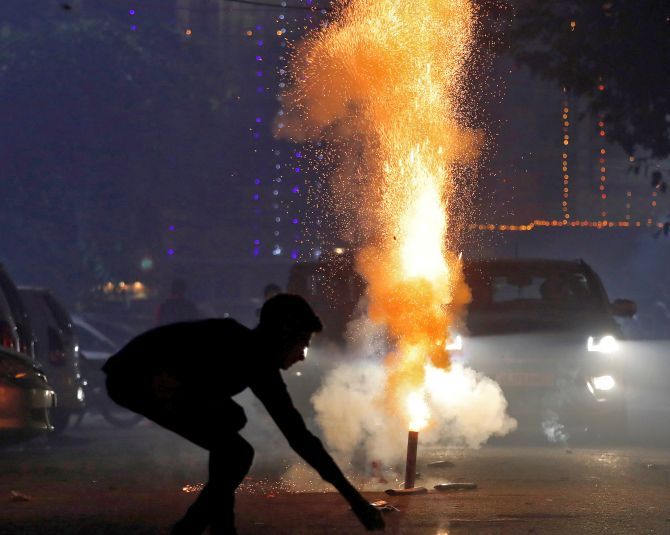The pollution levels in the national capital were 10 times the permissible limit due to rampant bursting of firecrackers.

A thick haze engulfed Delhi on Thursday as it recorded its worst air quality of the year the morning after Diwali, with the pollution level entering “severe-plus emergency” category or ten times the permissible limit due to rampant bursting of toxic firecrackers in gross violation of a Supreme Court order, authorities said.
While many residents and green activists voiced their helplessness at the violation of the Supreme Court’s 8 pm to 10 pm time limit of bursting firecrackers and expressed anguish, doctors advised people to stay indoors, use N-99 masks and not venture out.

The Delhi police said it had registered over 550 cases and arrested over 300 people for violating apex court’s order in this regard, while asserting that on Diwali day, it also seized 2,776 kg of firecrackers, arrested 87 people and registered 72 cases in connection with illegal sale of firecrackers.
Delhi Fire Services responded to over 300 calls on fire incidents triggered by firecrackers and LPG cylinder blast, among others, on Diwali night in Delhi, including an incident in which two children lost their lives and two others were injured. This, they said was much higher than previous years.
Over 250 cases of burn injuries were reported by various hospitals in the national capital this Diwali.

The Supreme Court has allowed people to burst firecrackers from 8 pm to 10 pm only on Diwali and other festivals. The top court also allowed manufacture and sale of just “green crackers” which have low emission of light, sound and harmful chemicals.
WATCH: Delhi engulfed in smog
The court said the police should ensure there was no sale of banned firecrackers and in case of any violation, the Station House Officer of the police station of the area would be held personally liable and this would amount to committing contempt of court.
But despite the Supreme Court’s order, certain places recorded violations where firecrackers were burnt before and after the set time frame.

The areas where the violations were recorded included Mayur Vihar Extension, Lajpat Nagar, Lutyens’ Delhi, IP extension, Dwarka and Noida Sector 78, according to a report.
The police admitted that violations were observed and it would take serious legal action against people violating the apex court order. They said they were continuously patrolling the areas to check for violations.
Partly as a result of smoke from the firecrackers, the overall air quality index in Delhi jumped to 574 which falls in the “severe-plus emergency” category, according to data by the Centre-run System of Air Quality and Weather Forecasting And Research.
A “severe plus emergency” AQI essentially means that even healthy people could suffer from respiratory illnesses on prolonged exposure. This air will seriously affect those with ailments, according to the advisory issued by SAFAR.

The overall AQI was 10 times the permissible limit.
An AQI between 0 and 50 is considered “good”, 51 and 100 “satisfactory”, 101 and 200 “moderate”, 201 and 300 “poor”, 301 and 400 “very poor”, and 401 and 500 “severe”. AQI above 500 falls in the “severe-plus emergency” category.
The sharp spike in pollution is caused by rampant burning of firecrackers that has led to the formation of a smoky layer across the national capital and drastically reduced visibility, the authorities said.
Delhi’s AQI is around 574 at present. Air Quality Index entered the “severe” category at 2 am after midnight on Thursday and will continue to remain in the “severe” category until evening, a senior official said.

The PM2.5 (particles in the air with a diameter of less than 2.5 micrometres) level recorded was at nearly seven times the permissable limit at 414. The PM10 (particles in the air with a diameter of less than 10 micrometres) level recorded was four times the permissible limit at 433.
India’s official permissible PM2.5 limit is 60 µgm-3 while PM10 level is 100 µgm-3.

Meanwhile residents expressed anguish over the pollution levels despite the order.
“Delhi is a gas chamber for tuberculosis patients like me. We are caught in a bind. If we escape TB, then we will die of pollution,” said Hasmukh Rai, a senior citizen of Mayur Vihar.
In this season, when everybody is talking of bringing ordinances on variety of issues, why can’t politicians join hands and bring ordinance to ban stubble burning?” he asked.

Environmental activists said the police needed to be supported by governments to strictly enforce the ban. “The judiciary has given our executive the necessary tools. We request our lawmakers to support our executive and all three arms of our democracy to work together to protect citizens health at this time of national health emergency,” said Jyoti Pande Lavakare, co-founder, Care for Air NGO.
“We would like our leadership and our prime minister to acknowledge this health emergency and encourage implementation of solutions,” she added.
Environmental lawyer Ritwick Dutta said the violation of the deadline was not unexpected as one cannot expect an overnight change in people’s behaviour. Doctors meanwhile advised people to take precautionary measures.
Arunesh Kumar, senior consultant, pulmonology, of a Gugaon hospital said: “It is highly advisable that people should stay indoors, use N-99 masks while venturing out and avoid early-morning and late-evening outdoor activities, among others.”










